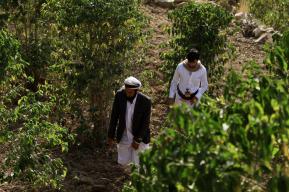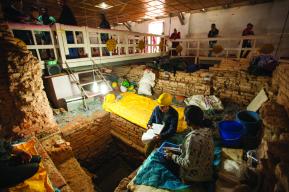Muhammed Al-Zubairi, a resident of Mutah neighborhood born and raised in the historic City of Sana’a, has spent his life forming a strong bond to the city. He shares a 900-year old massive building made of burnt brown bricks with his large extended family and calls it home. Muhammed’s family has been ingrained in the roots of the Old City with its complex and rich organic architecture that makes every building unique. He witnessed his five children grow up in this family house, playing among the endless staircases (raqad) leading to the panoramic terraces, the colorful narrow alleys, and the surrounding public gardens Bustans. Muhammed’s life suddenly changed when part of his house collapsed.“The roof of our house fell when my daughter was preparing dinner. A large segment of the house collapsed forcing our family to leave immediately. The building was already unstable because I could not afford to repair it and I feared for the life of my family. We were forced to find a temporary shelter somewhere else.”

Besides the dire humanitarian situation in Yemen resulting from the conflict, millions of Yemenis have lost their shelters during the past five years and were forced to displacement. In the historic urban centers, the direct and indirect effects of the conflict including the long-term lack of maintenance have undermined the structural integrity of historic buildings resulting in the precariousness and displacement of many residents.
The UNESCO/EU joint cash for work project was designed to prioritize private homes in four historic cities (Sanaa, Shibam, Zabid, and Aden) in a response to the needs resulting from the current conflict. A few monuments only are included such as the Sanaa National Museum and Aden Sultan Palace Museum. The combined focus on maintaining adequate and dignified shelters for inhabitants of historic urban centers, and safeguarding cultural Yemen’s cultural heritage is the common foundation that brought UNESCO and the European Union to implement this initiative. The three-year project aims at carrying out emergency interventions targeting 400 historical buildings in total.
The project does not only allow for emergency stabilization and rehabilitation of historic neighborhoods, it also alleviates the living conditions of the local population by creating income-generating opportunities for Yemeni youth who constitute over 70% of the local population. The project includes employment opportunities for 4,000 young male and female Yemenis over 500,000 cash working days. The implementation of a cash for work scheme in a World Heritage property is the first experiment of its kind within UNESCO. The involvement of skilled and unskilled local youth communities in rehabilitation sites is accompanied by mentoring and coaching provided by local master builders associations, ensuring the survival of traditional building techniques and the development of national cultural preservation resources.


Round beams at a distance of 50 cm. The organic materials are vulnerable, especially if in contact with humidity. Good plaster and regular renewal of whitewashing and plaster are essential.









